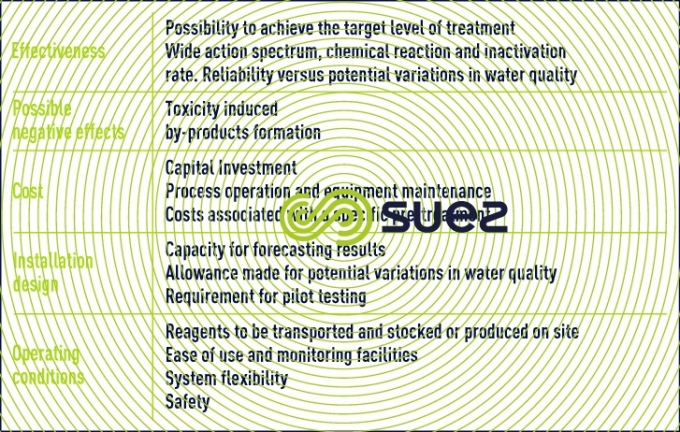criteria used when selecting oxidants and disinfectants
Reading time:Table 15 lists the main elements to be considered when selecting the best oxidation and disinfection technique. It could be that a combination of several techniques is recommended with the goal to achieve an objective while optimising the feedback to the various criteria listed below (to be weighted versus various risks).



As mentioned earlier, in all foreseeable applications and regardless of the agent involved, treatment effectiveness relies heavily on water quality, in relation to competing reactions and suitability of implementation with regard to reaction rates. Although access to reaction rates is relatively easy for the oxidation of organic and mineral compounds, doubts may persist for rates at which microorganisms are inactivated, due to the following:
- data spread;
- the difficulty in allowing for latency and deceleration phenomena;
- the difficult in clearly perceiving the effect made by the amount of disinfectant versus that of the contact time.
This aspect is particularly important when disinfecting drinking water.
The information displayed in oxidation and disinfection using chlorine, oxidation and disinfection using chlorine dioxide, oxidation and disinfection using ozone, ultraviolet disinfection provides the CT for different reagents to inactivate the same micro-organisms and therefore allow their effectiveness to be compared. Although the CT concept is simple to illustrate the effectiveness of a disinfectant (or of its use as described here before), the CT concept is a simplification and nowadays a CnTm type formula (Hom model) is considered as being more representative. Regardless of using the CT or the CnTm formula for sizing or controls caution must be exercised when evaluating C and T :
- T may be equal to T10, which characterises the hydraulics of the reactor or of each of the reactor’s compartments;
- the "effluent" method, based on residual disinfection concentrations at the reactor’s outlet is the simplest and safest method to use;
- the "geometric mean" method allows for the average concentration to be recorded over the actual contact time;
- the "CSTR reactor" method that takes into consideration progress made in the preparation of inactivation kinetic models inclusive of the calculation of the concentration of disinfection at all points throughout the reactor (USEPA recognised method and models). (See oxidation and disinfection using ozone figure 26 with the inclusion of the area below curve C).
Verifying that actual UV disinfection takes place is provided in the form of equipment certification and measurements (using UV sensors) of the actual intensity emitted by the lamps (see reactors used in drinking water applications).
Bookmark tool
Click on the bookmark tool, highlight the last read paragraph to continue your reading later












